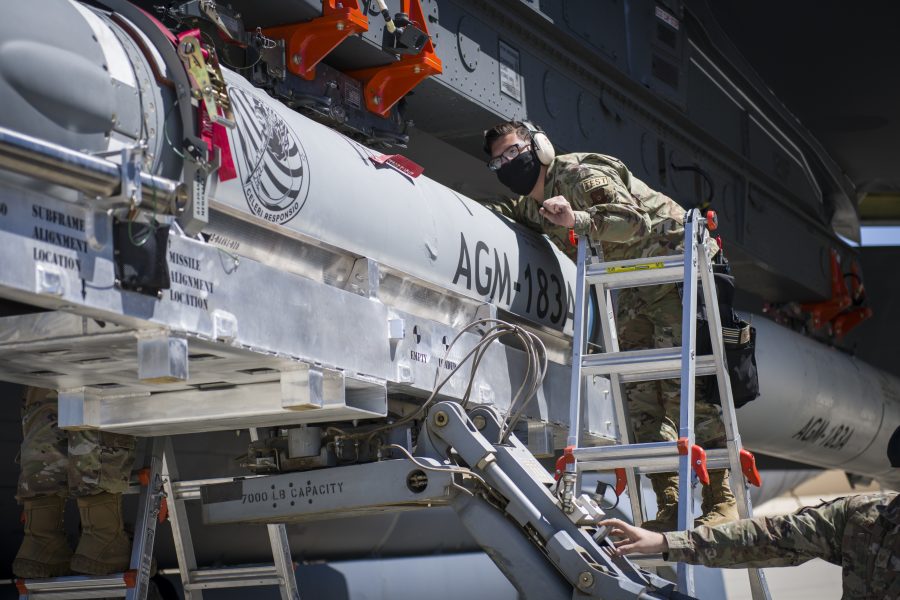The AGM-183A Air-launched Rapid Response Weapon will make its first all-up flight within the next seven days, following a recent failure of the system, hypersonics experts revealed at AFA’s virtual Aerospace Warfare Symposium. The system will go into production within a year.
“We actually have hardware built and are getting ready for our first booster flight test next week,” Brig. Gen. Heath A. Collins, program executive officer for weapons and director of the Air Force’s armament directorate, said in a panel discussion.
“So, there’s real hardware coming,” he said. “We’re also getting ready to transition into production in about a year on that program, so it will be the first air-launched hypersonic weapon that the Air Force has.”
Maj. Gen. Andrew Gebara, Global Strike Command director of strategic plans, programs and requirements, confirmed Collins’ remark, saying the ARRW test will happen “imminently,” and that “we’ll have operational capability … by ’22, or two AFA Orlandos from now.”
Collins said that “earlier this year … we had a slight bump on the road in test,” but the integrated government-industry team “focused, found the flaw, fixed the flaw, [and] got a corrective action in the air in less than 30 days … That just tells you that the team is really tight.”
Lockheed Martin is “part of that open transparency … But getting the right people at the right time on the program, to solve this failure and not miss a beat as we move forward … is a good example of how to get after” hypersonic development.
Sources reported an ARRW failure in late December, chalking it up to “dumb mistakes;” one reported that a technician failed to follow a checklist and another reported an improperly fastened control surface. Michael White, the principal deputy for hypersonics in the Pentagon’s directorate of research and engineering, seemed to confirm these reports in his panel remarks.
“We need to get it right the first time,” White said. “We have this mindset that we want to fail early and often so we can accelerate learning and actually develop quicker. But that’s only valid if your failures are because you’re learning about [technological] discoveries and the ability to do hypersonic flight. If our failures are that we forgot how to do a checklist, and tighten a pin on a fin, and we lose a flight vehicle because a fin falls off, that’s not acceptable failure.”
Adding engineering rigor to flights to make sure that everything is in readiness “is absolutely imperative,” he said.
Gebara also offered some new insight into how many hypersonic weapons GSC’s bombers will be able to carry.
Speaking about the ARRW and a follow-on air-breathing system, the Hypersonic Attack Cruise Missile, Gebara said: “I can put four ARRWs on a bomber, but I can put 20 HACMs on a bomber, if done right. Maybe more, if I have different pylon.”
He said GSC sees hypersonics as “being an evolutionary approach over time. What we don’t want to do is spend 20 years on one capability, and that’s all we get. We started ARRW. One of the advantages of ARRW … [is] it’s available, it’s good capability, it’s quick. We also want to get to that cruise missile capability.”
It would be “a shame,” he said, if the Air Force became “content with just one thing and that’s all we did. I think those days are behind us, and we need to work toward that evolutionary approach.”
Collins echoed the comment, saying it’s essential to build the infrastructure for continuous hypersonic weapon development.
“We need to start planning today for what comes next. We’ve got to keep that pump primed, keep our subject matter experts primed and focused on our challenges, not filtering off to pursue something else that they find more exciting.” The Air Force should “continue a solid stream of funding on the technological base to keep hypersonics moving forward, and then, the PEO and the program office, we need to … move with the speed of relevance, given maturing threats.”
He added that the best way to keep costs down on hypersonics is “not to start a huge, massive development every time you want a new capability. I think you develop the capability pipeline … agilely throughout the life cycle of a weapon system.”
